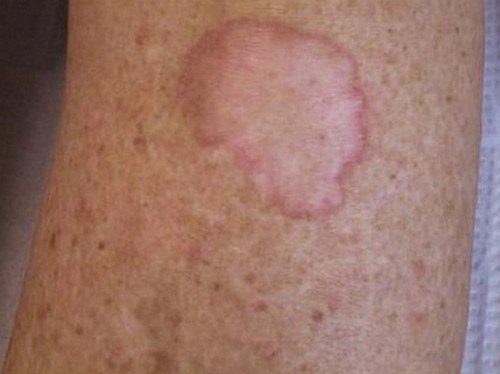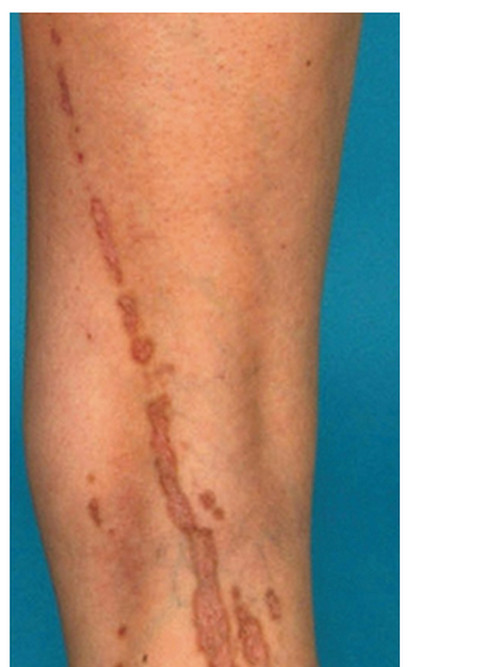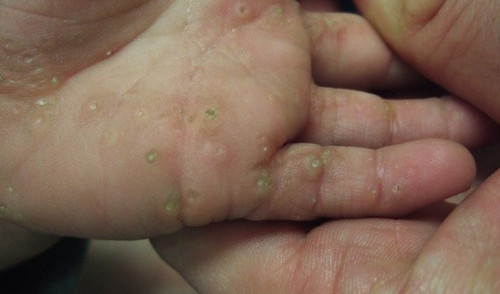A porokeratosis is a skin lesion characterized by thinned centre and surrounded by cornoid lamella (ridge-like border) caused by increasing number of ketatinocytes (skin cell surface). One of the common types of porokeratosis is Porokeratosis of Mibelli. (1)
Porokeratosis Pictures

Photo 1: A clinical manifestation of porokeratosis of mibelli.
Picture Source: img.medscapestatic.com

Photo 2: A patient suffering from disseminated superficial actinic porokeratosis.
Image Source: img.medscapestatic.com

Image 3: A patient demonstrating the symptoms of linear porokeratosis.
Photo Source: www.researchgate.net

Picture 4: Typical signs and symptoms of punctate porokeratotic keratoderma.
Image Source: escholarship.org
Types of Porokeratosis
What is Porokeratosis of Mibelli? Is usually begins in the childhood and in some instances, the lesions are present at birth. Lesions may also appear at puberty. It usually affects the limbs, especially the hands and feet.
It also affects the face, shoulders, neck, and even the genitals. There is a high possibility of developing skin cancer. (1, 2)
Disseminated actinic porokeratosis
What is disseminated actinic Porokeratosis? It is a skin condition characterized by reddish brown scaly spots. It usually affects the arms and legs, especially on sun-damaged skin. It usually runs in the genes, but it could also people with weakened immune system. Fair skinned people are more susceptible than dark skinned people. The incidence is higher in women than men. (2, 3)
Linear porokeratosis
What is linear Porokeratosis? It is an unusual skin condition characterized by a group of patches, each with ridged border and central furrow. It is called linear because they are arranged in one or more lines.
Porokeratosis of Mantoux
It causes tiny bumps of thickened skin on the soles and palms. It appears in the late childhood to early adulthood. It can be passed on the genes, but it can also affect people with no apparent family history of keratosis. (10)
Porokeratotic Eccrine Ostial and Dermal Duct Naevus (PEODDN)
These are congenital disorders but are very rare. It is present at birth and become prominent as the person grows older.
Punctate porokeratosis
it usually appears in adulthood, starts on the palms of the hands and soles of the feet and gradually spreads over the skin. The exact cause is unknown, but is linked with genetic and weakened immune system. It is also associated with previous skin injury. (4, 5)
Porokeratosis Causes
What are the causes of porokeratosis? Health care professionals strongly believed that porokeratosis is a genetic condition. However, even those who don’t have the genetic trait of porokeratosis also acquire the condition.
Hence, it is believed that anyone can get porokeratosis regardless if you have the family history or not. Other possible causes or porokeratosis are weakened immune system, excessive exposure to ultraviolet rays of the sun, radiation, and side effects of therapeutic phototherapy. (5, 6)
Porokeratosis Treatment
There is a variety of treatment options for porokeratosis. It usually includes using different types of creams and taking oral drugs to hasten the healing process. Advanced treatment approach is also needed to significantly improve the condition of the patient. It is a must to protect the skin from extreme heat of the sun so as to prevent the possibility of having skin cancer. (8)
When it comes to determining the best treatment approach, various factors need to be considered such as the size, location, and nature of the disease. If you have a porokeratosis, you are strongly advised to visit your doctor regularly to watch for any signs of skin cancer or worsening of the condition. If the condition gets worst, a surgery might be needed.
- Topical 5-fluorouracil – it is effective in the treatment of all types of porokeratosis. It can help improve the appearance of lesions and prevents remission of the disease.
- Vitamin D – It is effective after three to six months of treatment. It is helpful in the treatment of disseminated actinic porokeratosis. (5, 6, 7)
- Immunomodulators – It is helpful in the treatment of classic porokeratosis or also known as porokeratosis of Mibelli.
- Calcineurin inhibitors – It aids in the treatment of linear porokeratosis. It improves the symptoms like pain, paresthesia, and pruritus.
- Topical retinoids – it improves the symptoms of porokeratosis by reducing the hyperkeatosis of the edge of the lesion. It works in synergy with other treatment modalities for porokeratosis.
- Oral retinoids – It reduces the risk of carcinoma in porokeratotic lesions. (3, 5)
Surgical approach is intended for malignant form of porokeratosis. The typical surgical procedures are Cryotherapy, diamond fraise dermabrasion, electrodesiccation and curettage, photodynamic therapy, laser therapy, ultrasonic surgical type of aspiration, and excision.
Excision is the commonly used procedure. However, it can only be done based on the assessment of a health care provider. The extent of malignancy is also considered. Some doctors usually combine chemotherapy and surgical approach to get rid of the problem and reduce any potential risk.
What you can do to improve your condition?
- If you have a porokeratosis, it is important to protect your skin from further sun damage.
- When going out in the sun, make sure you wear sunscreen or wear long sleeves.
- You should take vitamin D supplements.
- Visit your dermatologist regularly.
- If you notice any changes in your skin or you notice new lesions, you need to inform your doctor right away. (6, 9)
Natural approach for porokeratosis
- Apple cider vinegar – It helps get rid of the skin condition after a few days of religious treatment. Apply apple cider vinegar directly on the skin. (8, 9)
- Organic virgin coconut oil – it would take some time for you to see the result. You should apply organic virgin oil on the affect part of the skin regularly. On the first phase of the treatment, the spots turn red and burn a little. After a few months, you will notice that the skin softens and the sports start to disappear. Apply virgin coconut oil once a day.
- Lavender oil – Apply lavender oil twice a day to clear up the spots on the skin.
- Green tea – It has astringent property, which makes it one of the best natural remedies for all types of porokeratosis. (4, 5)
- Tea tree oil – It is effective in the treatment of actinic keratosis. Tea tree oil has a powerful antimicrobial property. Before applying on the skin make sure you dilute it in a carrier oil such as coconut oil or lavender oil.
- Castor oil – Just like tea tree oil, castor oil is effective in treating actinic keratosis. It soothes burned and inflamed skin. It reduces the formation of spots, especially when applied religiously. (3, 4)
References:
- https://en.wikipedia.org
- emedicine.medscape.com
- www.dermnetnz.org
- www.firstderm.com
- www.pcds.org.uk
- https://rarediseases.info.nih.gov
- www.clinicaladvisor.com
- www.actasdermo.org
- www.dermpathmd.com
- Dermatopathology edited by Klaus J. Busam
